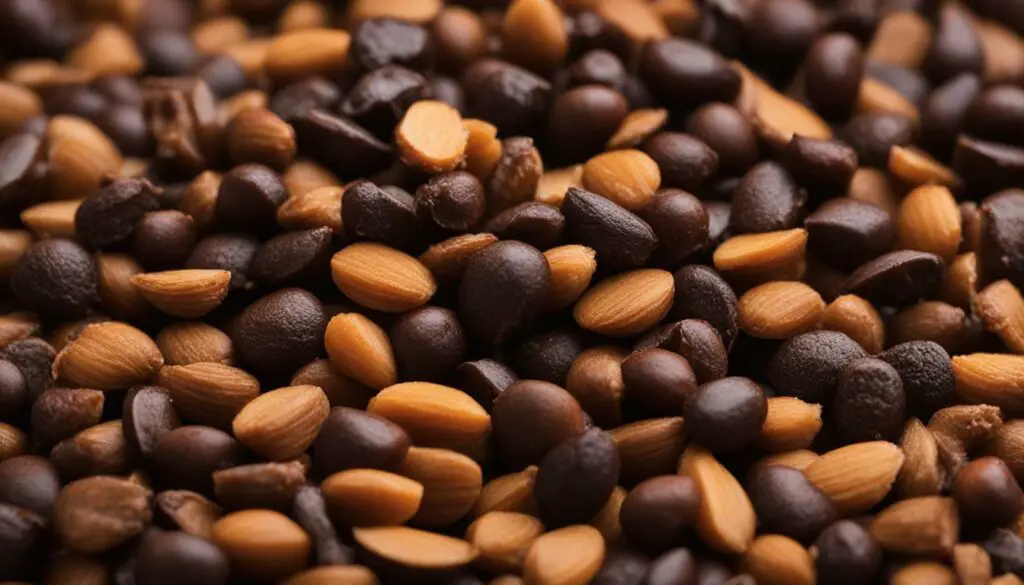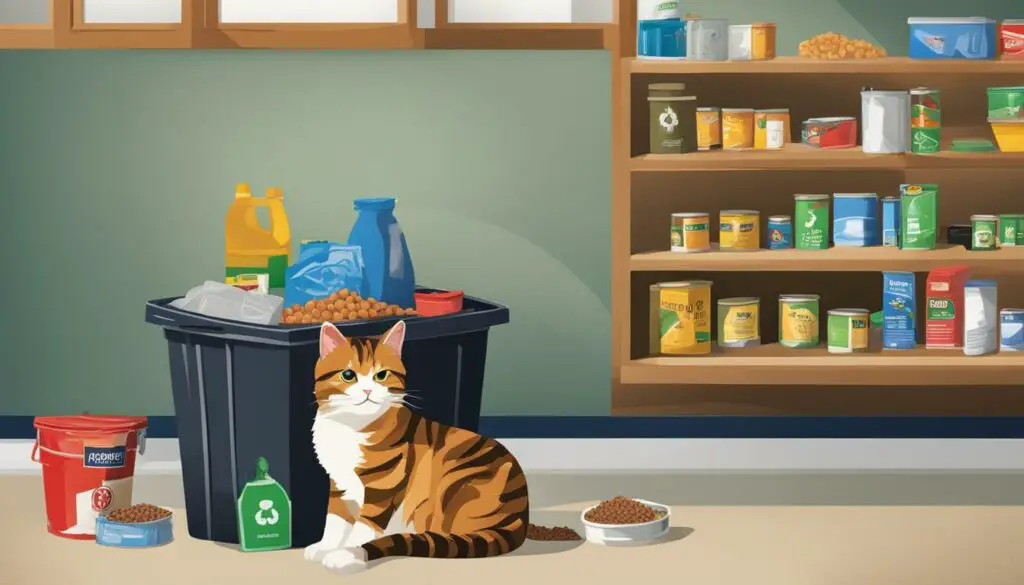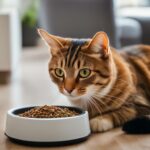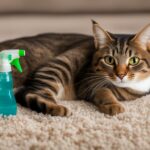As a cat owner, I’m sure you’ve experienced the pungent smell of cat food at some point. It can be quite baffling and concerning, leaving you wondering why it smells so bad. In this article, we will delve into the factors that contribute to the strong odor of cat food and explore the impact it has on our feline friends. So, let’s uncover the mysteries behind cat food smell and gain a better understanding of this common issue.
Key Takeaways:
- Cat food smell can be influenced by ingredients, preservatives, additives, and the manufacturing process.
- Cats have a remarkable sense of smell, with a higher number of olfactory receptors compared to humans.
- Proper storage, clean feeding areas, portion control, and ventilation are key in managing cat food smell.
- Individual preferences, vomeronasal organ, and nutritional quality play a role in a cat’s perception of food smell.
- Cat food smell can impact cat behavior, health, and the overall home environment.
Factors Contributing to Cat Food Smell
When it comes to the smell of cat food, several factors play a role in creating those distinct odors that can sometimes be less than pleasant. Understanding these factors can help cat owners make informed choices about their feline friends’ nutrition. Let’s take a closer look at the key contributors to cat food smell: ingredients, preservatives, additives, and the manufacturing process.
Ingredients:
The ingredients used in cat food can greatly affect its smell. Different protein sources, such as poultry, fish, or beef, have their own unique scents that can influence the overall smell of the food. Additionally, the quality and freshness of the ingredients can impact the odor. It’s important to choose cat food with high-quality ingredients to ensure optimal nutrition and minimize unpleasant smells.
Preservatives and Additives:
Preservatives and additives are commonly used in cat food to extend its shelf life and enhance palatability. However, some of these substances can contribute to the smell of the food. For example, certain preservatives may have a distinct odor that lingers in the food. It’s essential to carefully read the labels and choose cat food with natural preservatives and additives, or opt for preservative-free options to minimize any unwanted smells.
Manufacturing Process:
The manufacturing process plays a significant role in the development of cat food smell. Depending on the cooking method and processing techniques used, the food may undergo changes that can affect its scent. For example, extruded cat food, which is cooked at high temperatures, can have a different smell compared to raw or gently cooked food. It’s important to choose cat food that undergoes a manufacturing process that aligns with your preferences and your cat’s needs.
| Factors Contributing to Cat Food Smell | Description |
|---|---|
| Ingredients | The type, quality, and freshness of ingredients can impact the smell of cat food. |
| Preservatives and Additives | Some preservatives and additives used in cat food can contribute to its smell. |
| Manufacturing Process | The cooking method and processing techniques used in manufacturing can affect the scent of cat food. |
By considering the factors contributing to cat food smell, cat owners can make more informed decisions about their furry companions’ nutrition. Choosing cat food with high-quality ingredients, natural preservatives and additives, and a manufacturing process that aligns with preferences can help minimize any undesirable odors. Providing a balanced diet that meets your cat’s nutritional needs is key to ensuring their overall well-being and enjoyment of mealtime.
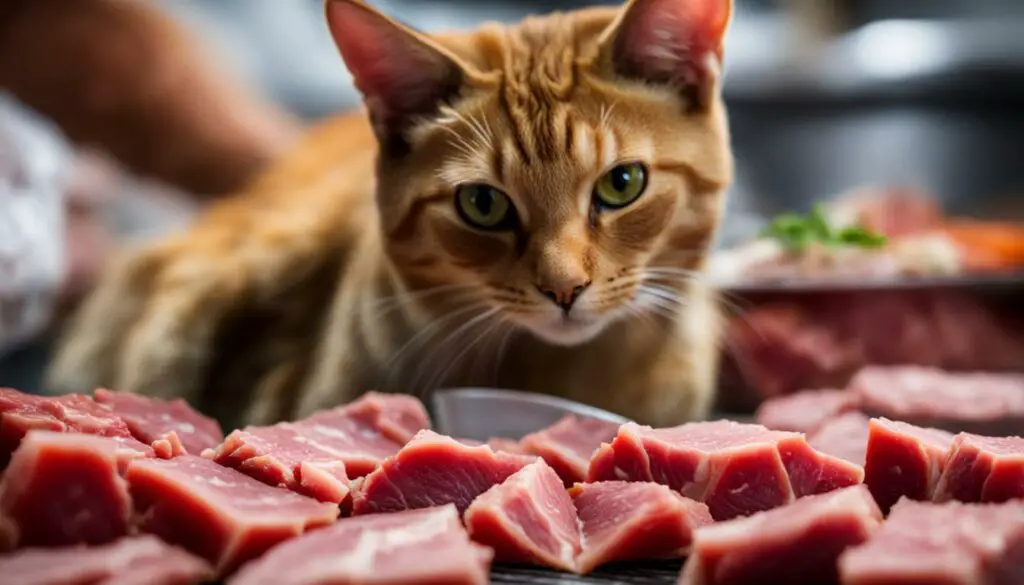
Cat’s Sensitivity to Smell
Cats have a remarkable sense of smell, with a higher number of olfactory receptors compared to humans. Their olfactory receptors are located inside their noses and are responsible for detecting and processing various scents in their environment. These receptors play a crucial role in a cat’s ability to navigate and understand the world around them.
One of the ways cats use their sense of smell is through scent marking. By rubbing their bodies or spraying urine, they leave behind scent molecules that act as a form of communication with other cats. This marking behavior helps establish territory and communicate their presence to others. It also helps cats feel more secure and confident in their surroundings.
Cat’s sensitivity to smell extends to their food preferences as well. They have the ability to detect subtle differences in smells, which can influence their food choices. This is why some cats may be more selective eaters and prefer certain flavors or aromas over others. Understanding a cat’s food preferences based on their sense of smell can help cat owners provide more enjoyable and satisfying meals for their furry friends.
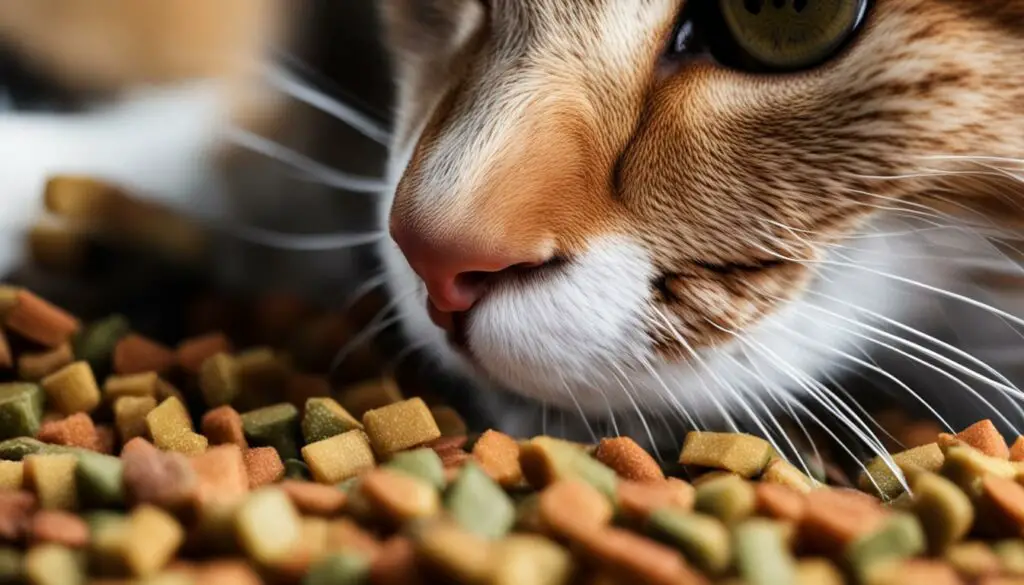
Table: Cat’s Sensitivity to Smell
| Aspect | Description |
|---|---|
| Olfactory Receptors | Cats have a higher number of olfactory receptors compared to humans, allowing them to detect a wide range of scents. |
| Scent Marking | Cats use scent marking as a form of communication and territory establishment. |
| Food Preferences | Cats have specific food preferences based on their sense of smell. |
“A cat’s sense of smell is truly remarkable. They can detect scents that are imperceptible to humans, allowing them to navigate their environment and communicate with others. Understanding their sensitivity to smell can help us provide a more enriching and satisfying experience for our feline friends.” – Dr. Emily Thompson, Veterinarian
When it comes to cat food smell, it’s important to consider the health and safety implications for our feline friends. The strong smell of cat food can have an impact on their appetite and overall well-being. Cats may be more sensitive to certain smells, leading to adverse reactions or health concerns. Here are some key health and safety considerations to keep in mind:
Dietary Sensitivities:
Just like humans, cats can have dietary sensitivities and allergies. Certain ingredients or additives in cat food can cause digestive issues, skin problems, or other adverse reactions. It’s important to carefully read the labels and choose cat food that is free from any potential allergens or ingredients that may trigger sensitivities.
Spoilage and Contamination:
Cat food that is not stored properly or exposed to air for prolonged periods can spoil and become contaminated. This can lead to bacterial growth and pose a health risk for your cat. Always ensure that you store cat food in airtight containers and follow the recommended storage guidelines provided by the manufacturer.
Hygiene Practices:
Maintaining proper hygiene practices is essential for your cat’s health and safety. Wash your hands before and after handling cat food to prevent the spread of bacteria. Clean your cat’s feeding bowls regularly with hot, soapy water to remove any residue or bacteria buildup. Additionally, ensure that your cat’s feeding area is clean and free from any potential sources of contamination.
Preventing Smell-Related Aversions:
Cats have a keen sense of smell, and strong food odors can sometimes deter them from eating. If your cat is exhibiting a decreased appetite or aversion to their food due to the smell, consider offering them a variety of food options to cater to their preferences. Additionally, providing fresh food and properly managing waste disposal can help mitigate strong smells and encourage healthy eating habits.
By taking these health and safety considerations into account, you can ensure a safe and enjoyable dining experience for your feline companion.
Cat’s Perception and Preferences
When it comes to the smell of their food, cats have unique perceptions and preferences. Their highly developed vomeronasal organ allows them to detect and process scents, including the smells associated with food. This organ plays a crucial role in their ability to communicate and gather information about their environment.
Each cat has individual preferences when it comes to food smells. Some cats may be attracted to the strong aroma of fish-based cat food, while others may prefer the milder scent of poultry. It’s important for cat owners to consider their cat’s preferences when choosing their food, as this can impact their enjoyment and willingness to eat.
In addition to individual preferences, cat owners should also prioritize the nutritional quality of their feline friend’s food. While cats may have specific smell preferences, it’s essential to ensure that their diet meets their nutritional needs. A balanced and nutrient-rich diet is crucial for their overall health and well-being.
| Factors influencing cat’s perception and preferences | Examples |
|---|---|
| Smell intensity | Strong aroma of fish-based cat food |
| Ingredient preferences | Prefer milder scent of poultry |
| Nutritional needs | Ensure a balanced and nutrient-rich diet |
Understanding a cat’s perception and preferences regarding food smell can help cat owners provide a satisfying and nutritious dining experience. By selecting food that appeals to their sense of smell and meets their nutritional needs, cat owners can ensure their feline companions enjoy their meals and maintain optimal health.
Managing Cat Food Smell
Properly managing cat food smell is essential for creating a pleasant environment for both cats and their owners. Here are some tips and strategies to help you minimize cat food odor:
- Proper Storage: Store cat food in airtight containers or resealable bags to prevent odors from spreading. This will also help maintain the freshness of the food.
- Clean Feeding Areas: Regularly clean your cat’s feeding bowls, mats, and surrounding areas to remove any food residue or spilled bits. This will help prevent the buildup of odor-causing bacteria.
- Portion Sizes: Avoid overfeeding your cat as excess food can contribute to unpleasant odors. Follow the recommended portion sizes based on your cat’s age, weight, and activity level.
- Serve Fresh Food: Feed your cat fresh food instead of leaving it out for extended periods. This will help minimize the chances of food spoilage and associated odor.
- Proper Waste Disposal: Dispose of cat food cans, pouches, and any uneaten food properly. Seal them in a bag and place them in a covered trash bin to prevent the odor from lingering.
- Smell-Absorbing Solutions: Use odor-absorbing products, such as baking soda or activated charcoal, near your cat’s feeding area. These can help absorb and neutralize odors.
- Ventilation: Ensure proper air circulation in your home, especially in areas where you feed your cat. Open windows or use fans to help dissipate any lingering odors.
By following these management techniques, you can maintain a fresh and odor-free environment while keeping your cat’s well-being in mind.
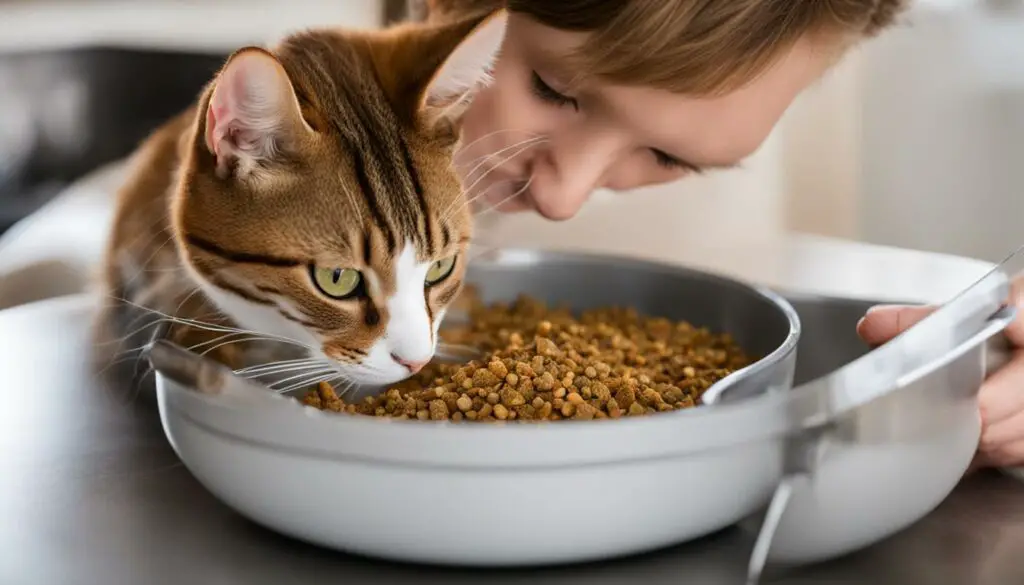
Table: Comparison of Smell-Absorbing Solutions
| Solution | Effectiveness | Usage |
|---|---|---|
| Baking Soda | Good | Place an open box near the feeding area or sprinkle a small amount on the floor before vacuuming. |
| Activated Charcoal | Excellent | Put charcoal pellets or granules in a breathable container and place them near the feeding area. |
| Vinegar | Fair | Mix vinegar with water and use it to wipe down surfaces near the feeding area. |
| Coffee Grounds | Fair | Place used coffee grounds in an open container near the feeding area. |
Remember to choose solutions that are safe for cats and follow the recommended usage instructions. Experimenting with different options may help you find the most effective solution for managing cat food smell in your home.
Cat Food Smell and Human Perception
The smell of cat food can elicit different reactions from humans, influenced by factors such as individual sensitivity, odor tolerance, personal preferences, and cultural factors. Some individuals may find the smell of cat food unpleasant, while others may not be bothered by it at all.
Human sensitivity to smells varies, and what may be overpowering to one person might not be noticeable to another. Odor tolerance also plays a role in how humans perceive the smell of cat food. Some individuals may have a higher tolerance for strong odors, while others may be more sensitive.
“The smell of cat food reminds me of my childhood. I had cats growing up, and every time I open a can of cat food, it takes me back to those happy memories.” – Cat owner
Personal preferences also come into play when it comes to the perception of cat food smell. Some individuals may enjoy the aroma of cat food, associating it with positive experiences or pleasant memories. Others may find the smell off-putting or disagreeable.
Cultural factors can also influence how cat food smell is perceived. Different cultures have varying culinary traditions and preferences, which can impact the perception of smells associated with different types of food, including cat food.
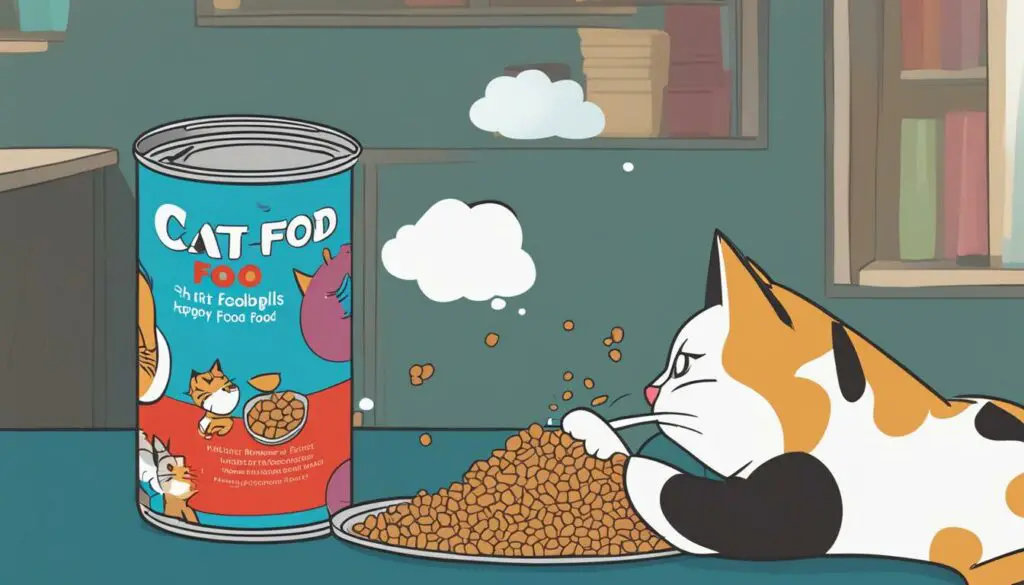
Factors Influencing Human Perception of Cat Food Smell:
- Individual sensitivity to smells
- Odor tolerance
- Personal preferences
- Cultural factors
| Individual Sensitivity | Odor Tolerance | Personal Preferences | Cultural Factors |
|---|---|---|---|
| Can vary among individuals | Some people have a higher tolerance for strong odors | Differ from person to person | Cultural traditions and preferences can impact perception |
| Can be influenced by genetics and previous experiences | May be affected by exposure to certain smells | Associations with positive or negative memories can shape preferences | Food traditions and societal norms play a role |
The Impact of Cat Food Smell on the Home Environment
When it comes to cat food smell, the impact on the home environment can be quite significant. The strong and often unpleasant odor can permeate the air, creating an uncomfortable living space for both cats and their owners. Proper odor control is essential to maintain a pleasant atmosphere and ensure the well-being of everyone in the household.
To combat the unpleasant smell, it’s important to establish regular household cleaning routines. This includes not only cleaning the cat’s feeding area but also regularly wiping down surfaces and floors to eliminate any lingering odors. Additionally, using odor-absorbing solutions and air fresheners can help mask any remaining smells and create a more pleasant environment for both cats and humans.
Furthermore, proper storage of cat food also plays a crucial role in controlling the smell. Storing cat food in airtight containers can help prevent the odor from spreading throughout the house. It’s also important to dispose of any leftover or expired cat food properly, as this can contribute to the overall smell in the home.
| Odor Control Tips | Benefits |
|---|---|
| Establish regular cleaning routines | Eliminate lingering odors |
| Use odor-absorbing solutions and air fresheners | Create a more pleasant environment |
| Store cat food in airtight containers | Prevent odor spread |
| Properly dispose of leftover or expired cat food | Reduce overall smell |
By implementing these odor control strategies and maintaining good hygiene practices, cat owners can effectively manage and minimize the impact of cat food smell on the home environment. It’s important to create a clean and pleasant living space that both humans and cats can enjoy.

Quote:
A clean and odor-free home not only benefits humans but also contributes to the overall well-being of our feline companions.
The Link Between Cat Food Smell and Cat Behavior
Cat food smell not only affects the aroma in your home but also plays a significant role in influencing your cat’s behavior. The scent of their food can have a direct impact on their eating behavior, appetite stimulation, food aversion, and even trigger their natural food hunting instinct.
When it comes to eating behavior, the smell of cat food can entice or discourage a cat from consuming their meal. A pleasant aroma can stimulate their appetite and make mealtime more enjoyable. On the other hand, if the smell is unappealing or off-putting to a cat, they may exhibit a decreased interest in eating or even refuse their food altogether.
The smell of cat food can also evoke a cat’s natural hunting instinct. Cats have a keen sense of smell that helps them locate prey in the wild. The strong aroma of their food can trigger this instinct, making the act of eating a more stimulating and engaging experience for them.
Additionally, some cats may develop a food aversion or preference based on the smell of certain types of cat food. If a particular scent is associated with a negative experience or if they have a strong preference for a specific aroma, they may gravitate towards or avoid certain foods.
Solutions to Address Behavioral Concerns
To address any behavioral concerns related to cat food smell, there are a few strategies you can consider:
- Offering a variety of smells and flavors: Providing a range of options allows you to cater to your cat’s preferences and may encourage them to eat more consistently.
- Ensuring nutritional quality: While appealing smells are important, it’s essential to prioritize the nutritional value of the food you offer to maintain your cat’s overall health and well-being.
- Monitoring portion sizes: Controlling portion sizes can help prevent overeating or undereating, ensuring your cat maintains a healthy weight and appetite.
- Seeking veterinary advice: If you notice significant changes in your cat’s eating behavior or appetite, it’s recommended to consult with your veterinarian to rule out any underlying health issues or concerns.
By understanding the link between cat food smell and behavior, you can make informed decisions about your cat’s diet and create an environment that promotes their overall happiness and well-being.
| Behavioral Aspect | Impact of Cat Food Smell |
|---|---|
| Eating behavior | The smell can stimulate or discourage a cat’s appetite. |
| Appetite stimulation | A pleasant aroma can enhance a cat’s desire to eat. |
| Food aversion | An unappealing smell can lead to a cat avoiding certain foods. |
| Food hunting instinct | The strong aroma can trigger a cat’s natural hunting behavior. |
Understanding the impact of cat food smell on behavior allows cat owners to tailor their approach to feeding and address any concerns that may arise.
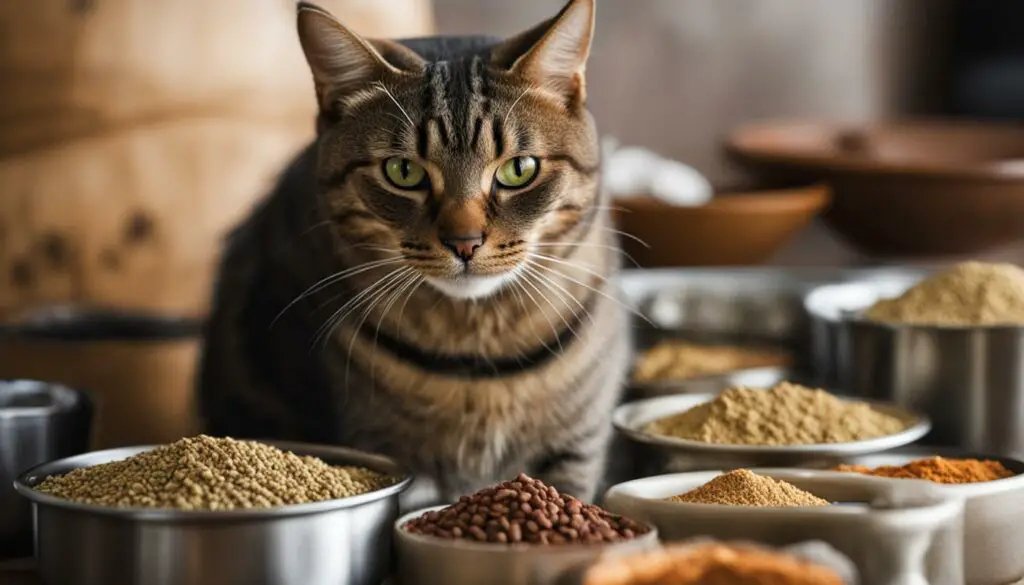
Cat Food Smell and Cat Health
The smell of cat food can have a significant impact on a cat’s health and overall well-being. Cats are known for their sensitive digestive systems, and certain smells can trigger digestive issues, allergies, and intolerances. It is crucial for cat owners to understand the potential effects of cat food smell on their feline companions.
Digestive issues are one of the most common health concerns related to cat food smell. Cats may experience gastrointestinal upset, such as vomiting or diarrhea, when they consume food with strong or unpleasant smells. Additionally, certain ingredients or additives in cat food can affect nutrient absorption, leading to deficiencies or imbalances in their diet.
Allergies and intolerances are another consideration when it comes to cat food smell. Some cats may develop allergies to specific ingredients, resulting in skin irritations, itching, or gastrointestinal symptoms. Similarly, cats can have intolerances to certain components in their food, leading to digestive discomfort and other health problems.
| Allergies | Intolerances | Digestive Issues |
|---|---|---|
| ✓ Skin irritations | ✓ Digestive discomfort | ✓ Vomiting |
| ✓ Itching | ✓ Nausea | ✓ Diarrhea |
| ✓ Gastrointestinal symptoms | ✓ Bloating | ✓ Nutrient imbalances |
To ensure the optimal health of their cats, owners should closely monitor their cats’ reactions to different smells and ingredients in their food. If a specific smell or type of food consistently causes adverse reactions, it may be necessary to switch to a different brand or formulation that better suits their cat’s needs. Consulting with a veterinarian can provide valuable guidance and help identify any underlying health concerns.
Feline Preferences and Solutions for Cat Food Smell
Cats have unique preferences when it comes to the smell of their food. Just like humans, they have individual tastes and preferences that can vary greatly. As a cat owner, it’s important to understand these preferences and find the right solutions to manage cat food smell.
Providing a variety of smells and flavors is one way to address cat food smell concerns. Cats can get bored with the same food day after day, so offering different options can keep their interest and prevent them from becoming disinterested in their meals. Experimenting with different smells and flavors may require some trial and error to find the ones that your cat loves the most.
In addition to variety, it’s crucial to provide nutritious food options for your cat. High-quality, balanced diets not only meet their nutritional needs but can also contribute to a healthier coat and overall well-being. Look for cat food that contains real meat as the main ingredient, as this can enhance the smell and appeal to your cat’s natural instincts.
It’s important to remember that every cat is unique, and what works for one may not work for another. Pay attention to your cat’s individual needs and preferences. Some cats may prefer wet food over dry food, while others may enjoy a mix of both. Understanding and accommodating your cat’s preferences will go a long way in managing cat food smell and ensuring they have a satisfying dining experience.
Table: Variety of Smells and Flavors for Cat Food
| Smell/Flavor | Description | Benefits |
|---|---|---|
| Fish | Strong aroma that appeals to many cats | High in omega-3 fatty acids for a healthy coat |
| Chicken | Mild scent that is generally well-received | Rich in protein for muscle development |
| Beef | Rich and hearty smell that some cats adore | Provides essential nutrients like iron and zinc |
| Lamb | Milder scent that can be a good alternative | Easily digestible and suitable for cats with sensitivities |
By considering your cat’s individual needs and exploring a variety of smells and flavors, you can effectively manage cat food smell and ensure your furry friend enjoys mealtime. Remember to consult with your veterinarian for personalized advice and recommendations.
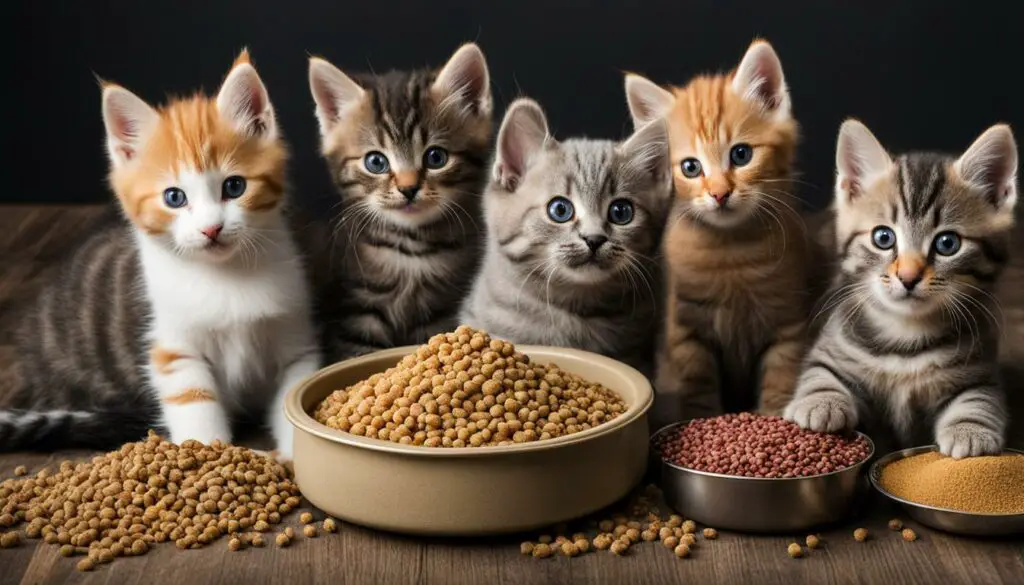
The Role of Cat Owners in Managing Cat Food Smell
As cat owners, we play a crucial role in managing the smell of cat food. By implementing proper feeding practices, maintaining clean feeding areas, practicing good hygiene, and maintaining a clean home environment, we can create a pleasant dining experience for our feline friends and ensure their overall well-being.
One important aspect is to establish proper feeding practices. This involves providing our cats with the appropriate portion sizes and ensuring that their food is always fresh. By following the recommended guidelines for feeding and storing cat food, we can prevent spoilage, contamination, and unpleasant smells.
To maintain a clean feeding area, it’s essential to regularly wash and sanitize your cat’s bowls and dishes. This helps prevent the build-up of bacteria and food residue, which can contribute to strong odors. Additionally, keep the feeding area free from clutter and debris to create a clean, inviting space for your cat to enjoy their meals.
Good hygiene practices extend beyond just the feeding area. Regularly scooping and disposing of cat waste, as well as using smell-absorbing solutions or litter deodorizers, can help minimize unpleasant odors in your home. Adequate ventilation, such as opening windows or using air purifiers, can also improve air quality and help manage cat food smells.
| Feeding Practices | Clean Feeding Areas | Hygiene | Home Environment Maintenance |
|---|---|---|---|
| Provide appropriate portion sizes | Regularly wash and sanitize bowls | Dispose of cat waste properly | Use smell-absorbing solutions |
| Serve fresh food | Keep feeding area clutter-free | Use litter deodorizers | Ensure adequate ventilation |
| Follow recommended guidelines | Prevent bacteria build-up | Manage litter box odors | Open windows or use air purifiers |
By taking an active role in managing cat food smell, we can create a more pleasant environment for both our cats and ourselves. Implementing these practices not only helps address odor concerns but also contributes to the overall health and well-being of our beloved feline companions.
Conclusion
After exploring the factors contributing to the strong smell of cat food, it becomes evident why cat food can sometimes smell so bad. The ingredients, preservatives, additives, and manufacturing process all play a role in determining the odor of cat food. As cat owners, it’s important that we understand these factors and their impact on our cats’ health and behavior.
Managing cat food odor requires a multi-faceted approach. From proper storage and clean feeding areas to portion control and using smell-absorbing solutions, there are various strategies we can employ to minimize the smell. Adequate ventilation and focusing on maintaining a clean home environment also contribute to managing cat food smell.
It’s essential to consider the link between cat food smell and our cats’ well-being. The way food smells can affect their appetite, digestion, and overall health. By providing a variety of smells and flavors, nutritious food options, and considering individual needs, we can address cat food smell concerns and ensure our cats’ optimal care.
Ultimately, as cat owners, we have a responsibility to manage cat food smell. By following proper feeding practices, maintaining clean feeding areas, practicing good hygiene, and keeping our home environment clean, we can create a more enjoyable dining experience for our cats and a pleasant living environment for ourselves.
FAQ
Why does cat food smell so bad?
The smell of cat food can be influenced by factors such as ingredients, preservatives, additives, and the manufacturing process.
What factors contribute to the smell of cat food?
The smell of cat food can be influenced by ingredients used, the presence of preservatives and additives, and the manufacturing process.
How does a cat’s sense of smell affect their food preferences?
Cats have a remarkable sense of smell and use it to communicate and have specific food preferences based on their sense of smell.
Can the smell of cat food impact a cat’s appetite and overall well-being?
Yes, the strong smell of cat food can have an impact on a cat’s appetite and overall well-being. Cats may be more sensitive to certain smells and may exhibit adverse reactions or health concerns.
How should cat owners manage and minimize cat food smell?
Cat owners can manage and minimize cat food smell by practicing proper storage, maintaining clean feeding areas, portion control, serving fresh food, proper waste disposal, using smell-absorbing solutions, and ensuring adequate ventilation.
Can humans perceive the smell of cat food differently?
Yes, the perception of cat food smell can vary among humans due to individual sensitivity, odor tolerance, personal preferences, and cultural factors.
How can the strong smell of cat food impact the home environment?
The strong smell of cat food can create an unpleasant odor in the home. Proper odor control, regular household cleaning routines, and the use of air fresheners can help maintain a pleasant living environment.
Can the smell of cat food affect a cat’s behavior?
Yes, the smell of cat food can influence cat behavior, including eating behavior, appetite stimulation, food aversion, and the expression of their natural food hunting instinct.
What impact can the smell of cat food have on a cat’s health?
The smell of cat food can impact a cat’s health, including digestive issues, nutrient absorption, allergies, intolerance, and overall well-being.
How can cat owners address cat food smell concerns?
Cat owners can address cat food smell concerns by providing a variety of smells and flavors, offering nutritious food options, and considering individual needs. Some trial and error may be required to find the right balance.
What role do cat owners play in managing cat food smell?
Cat owners play an important role in managing cat food smell by practicing proper feeding practices, maintaining clean feeding areas, practicing good hygiene, and maintaining a clean home environment.

